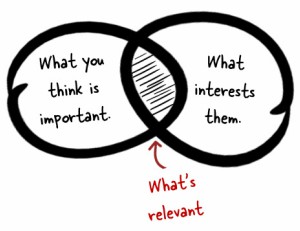5 Foundational PPC Ad Copy Tips Just for B2B Advertisers
As we know from previous posts, your B2B prospects can vary widely as there are likely multiple stakeholders in all different stages of the buying process. They range from unaware of your product’s/service’s existence to ready to buy. Since this is the case, you’re going to see the best results by matching up your ad copy with your audiences, their likely stage in the buying process, and your offer. So before you write your ads, make sure you’ve done your research and know your audiences really well.
Ultimately, it matters less that your ad copy follows common practices or implements brilliant psychological tactics if it isn’t highly relevant to the audience that’s seeing it. Do this first, then you can move on to being brilliant, creative and awesome with how you communicate that message.
There’s an array of advice on making great PPC ads – from making sure you cater to emotions, to matching your ad headline to your landing page headline, to taking full advantage of applicable ad extensions.
But we’re focusing specifically on B2B here. Therefore, I’m going to lay out 5 ad copy tips I believe should be prioritized when doing PPC in the B2B space and the reasons you should do so.
Clearly pre-qualify clicks
When targeting ads online, you don’t always know exactly who you’re reaching and if they’re exactly the type of person you want clicking your ads and viewing your offer. Whether you’re advertising on more general keywords that lack a lot of search intent, websites that may be attracting your audience, or social network audiences based on interests or similarities that relate to your customers; you’re going to want to make sure you’re pre-qualifying your clicks with your ad copy.
As much as we want our ads to be clicked, we only want the right people clicking them. There’s no sense in driving clicks from people that will come to your site just to turn right back around and leave.
In B2B more than B2C, you don’t necessarily want to go after the highest click-through rates you can get if by doing so, the money you save from lower Cost Per Clicks doesn’t offset the waste of paying for clicks from people that just won’t be interested in your offer.
So how can you effectively attract the right type of clicks?
- Get granular. Let’s say you’re advertising for a company that offers thermostats. But more specifically, they offer smart thermostats for rooms in hotels, hospitals and other commercial buildings. If you’re going to target all queries with thermostats in them (You probably won’t at the start, see this post about B2B keywords), you’ll need to communicate to them that you only have what they’re looking for if they fit your target audience. If they get more specific and search for thermostats for hotels, they’re telling you exactly what type of commercial building they need the thermostats for. So in this case, you’ll want to communicate back if the thermostats work for hotels or not. Additionally, you may want to say if they only work for certain hotels if that’s the case. Either way, the searcher knows if they should be interested in what you have to offer or not.
- Include pricing. The higher prices that B2B typically demands should quickly disqualify non-audience members.
- Include applicable business sizes. Use qualifiers like enterprise, small business or smb to communicate who your offer is for.
- Include applicable industries. Only serve specific verticals? Mention them.
- Include applicable job titles. Do you know your audience is only made up of CEOs? You can really stand out if you speak right to them.
- Include your location. While you might service the searcher’s area, there’s a chance the searcher is only interested in companies close to them. Having them click through to find out you’re in a different state and immediately disqualify you because of it is a waste.
Purposefully differentiate from competitors
In the B2C space, advertisers might focus on creating a sense of urgency, FOMO (fear of missing out), or any number of other psychological tactics to attracts clicks. But for B2B, these may not be as important because you’re likely not getting the customer to purchase right now no matter how good your campaigns are.
Therefore, you want to focus on the key differentiators that cause you to stand up well against the competition. It’s the long-term benefits you offer compared to your competitors that will likely be most effective at getting your customers’ attention.
Since many online ad formats don’t have a lot of character space, we can’t include all of the features, benefits, adjectives, qualifiers, etc. that we would like to. So it’s important that we focus on those things that will persuade our customers that we should be one of the options they vet for our solutions. Providing your unique position in the marketplace is one of the best ways to do that.
You may offer smart devices for rooms in commercial buildings to save on energy costs. But other companies do that too. What no one else does is create a comprehensive line of products that are scalable over time. Customers can outfit their buildings with just the thermostats to start. But they can then integrate other products seamlessly as time goes on and budget allows. This allows companies to take an incremental approach to solving their high energy costs without having to change their systems every few years.
You can imagine that a detail like that can pack quite a punch. If you have a differentiator in relation to your competition, you’re going to want to communicate that up front.
Boastfully establish trust & credibility
Because customers are making large investments and typically looking for longer-term relationships, elements that establish trust and credibility tend to be even more important than in the B2C space. The most common ways companies can do this in their ads are by highlighting…
- Awards the company has won
- Popular media outlets the company has been featured on
- Case studies that highlight successes
- Reputable customers you’ve done business with
- Testimonials from customers
- Industry certifications that are important
- Your experience in the industry
- Memberships in trade groups or associations
Carefully promote appropriate offers
What should you offer in your ads? Well, that depends on where the customer is in the trusty old marketing buying funnel. So let’s take a look at each stage of the funnel and what kinds of offers (and therefore ad copy) would make sense to customers in each of them.
Get in my funnel
For the most part, if people aren’t in your buying funnel yet, then the goal of your campaign will be to drive awareness from new prospects. These prospects either don’t know you exist or don’t know that you have something valuable to offer them. In this stage, you’re typically targeting audiences with firmographics that fit your target – job titles, business size, industry, etc. To your knowledge, they aren’t aware you exist or at least haven’t performed any behaviors you can target that shows they’re interested in what you have to offer.
If this is the case, the primary purpose of your ad copy should be to drive a connection with your target audience by offering them information that will get them interested in you. You’re going to want to educate your audience as to why they need your solution. For example, you might say…
See why your hotel may be missing out on saving 20-40% on room energy costs. Download our whitepaper (or watch this video, or read this case study, etc.).
In this stage, these prospects haven’t been thinking about your products/services at all. You are getting their attention. So at this point, they don’t necessarily care what the products cost, how they integrate with their systems or how to use them. What will get their attention is demonstrating how you can improve their lives; usually by demonstrating how you’ve already improved others’ lives.
Your ad copy and offer should reflect that.
Top of the funnel
The top of the funnel will typical employ similar strategies as “get in my funnel,” but is directed at people that have shown some kind of intent. In this stage, you’re typically targeting audiences with behaviors that fit your target – they have searched with specific keywords, or have engaged with certain brands on social media. But, their behavior hasn’t signaled to us any intent that they’re looking to purchase.
Maybe they searched with some kind of generic query that’s superficially related to what you’re offering. For example, maybe my example company would target people searching with building energy management keywords. Although they’re not specifically searching for what I’m offering, they’re showing interest that’s related as a bigger theme to my offer. These are good prospects to go after.
But again, you’re not necessarily offering them what they’re looking for. So it’s likely best to stick with educating them as to how your solution fits into the grander scheme of what they’re searching for. For example, you might say…
Learn how smart occupancy sensing devices are changing the way buildings manage their energy. Download our whitepaper (or watch this video, or read this case study, etc.).
In this stage, you’ve moved from gaining their attention to driving their interest.
Middle of the funnel
The middle of the funnel contains customers that have shown some kind of expressed interest in what you’re offering. Maybe they searched specifically for thermostats for hotels, which signals they already know what you’re offering is the solution. They just don’t know if YOU’RE the solution they’re looking for. They’re likely doing research and comparisons.
In this stage, it’s all about persuading the customer that you’re the choice for them. It’s where you really hit them hard with the information you believe is your best shot at being one of the company’s they want to vet further by making personal contact with you. You might say…
Receive a free energy audit to learn how our devices will integrate seamlessly with your energy management platform to help you save.
In this stage, you’ve moved from getting customers interested to driving their desire to engage with you.
Bottom of the funnel
This is the stage everyone loves (of course) and overvalues, since it’s mostly just an outflow of good upper funnel tactics. The bottom of the funnel contains customers ready to purchase. They’ve decided you’re the right fit for them and it’s time to close the deal. They’ve established contact with you through downloading your content and interacting with your sales team. Now, they’re likely searching with your brand keywords or viewing your emails.
Really your best approach here is making sure the process is as straightforward as possible so you don’t frustrate them and cost yourself a sale. You might present an offer like this…
Integrate energy saving devices in your hotel today and start saving up to 40% on energy costs. Contact us now!
If the customer is ready to purchase, you’ve made it very clear about how to do that. They don’t need more of your content and they don’t need more of your persuasion. They just need that extra emotional push and an easy way to get the purchase process rolling.
Strategically place the right calls to action
Once your offers are aligned with the stages of the buying funnel, your calls to action will naturally follow suit. Very rarely are you going to want to ask prospects in the B2B space to “Buy Now.”
If they’re at the beginning stages of the process (learning about you or comparing solutions), they’re going to want to collect valuable information that answers any questions that may arise from decision-makers or other key stakeholders. So encouraging them to buy is counterproductive. As we saw above, it’s really only appropriate in the bottom of the funnel stage; maybe on your brand keywords or through your email advertising.
Here are some of the common call to action words that make sense to use in each stage of the funnel…
- Get in my funnel: Watch, See, View, Read, Discover, Uncover, Check Out, Visit
- Top of the funnel: Learn, Follow, Connect
- Middle of the funnel: Contact, Request, Start, Verify, Access, Receive
- Bottom of the funnel: Call, Register, Purchase, Checkout, Donate
When a B2B PPC program first begins, I believe incorporating these 5 ad copy tips into the strategic plan lays an initial foundation for success. On the other hand, if you happen to have been running campaigns for a while now and see room for improvement in your results, try testing these concepts against your current strategy and see if they don’t provide a welcome boost in performance.
This is Part 3 of a B2B PPC series. See other posts in the series…
B2B Audiences: How To Create & Effectively Use Them For PPC
How To Carefully Choose & Use Keywords For Your B2B PPC Campaigns






